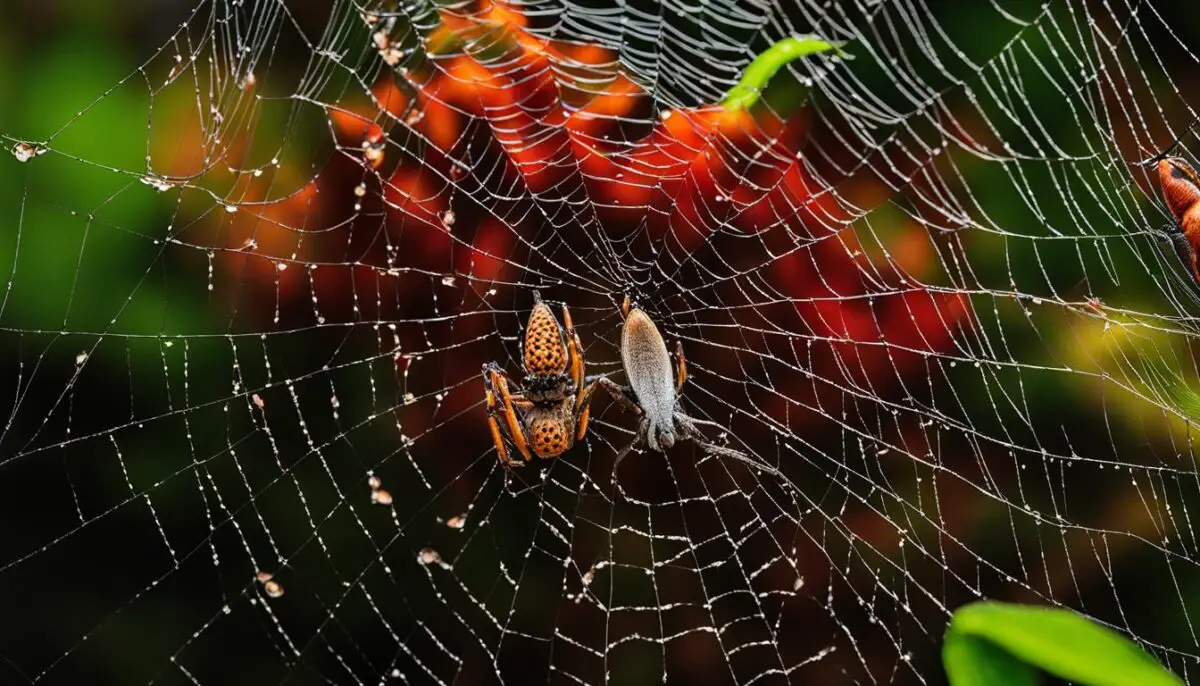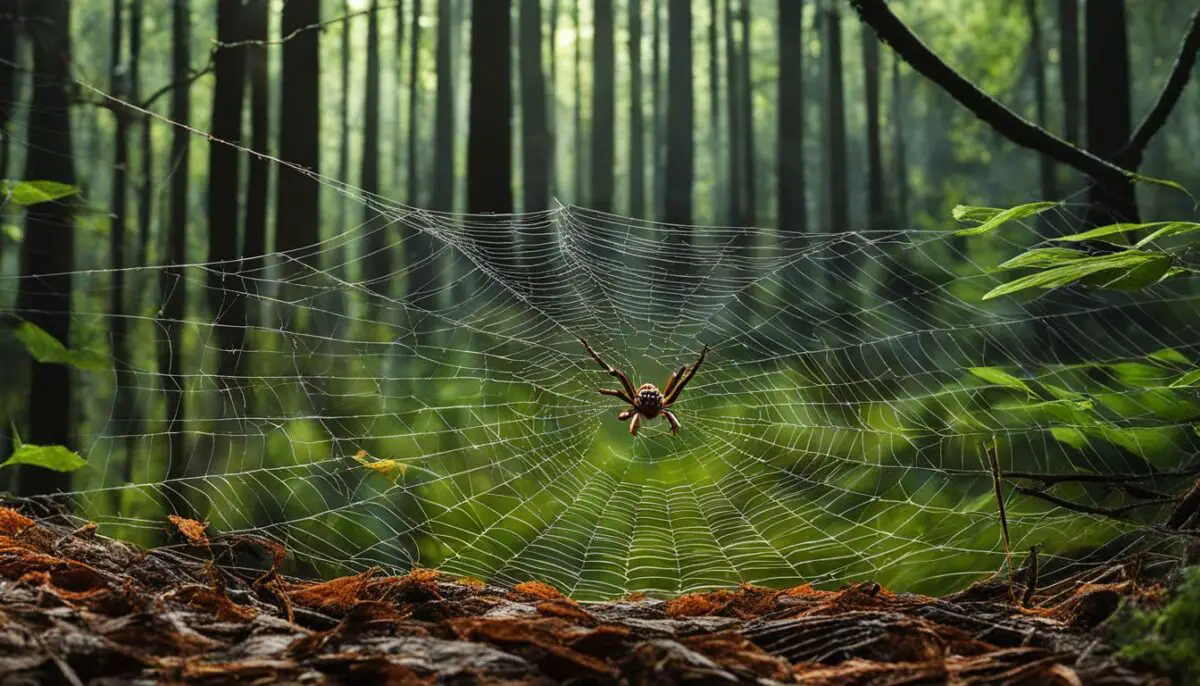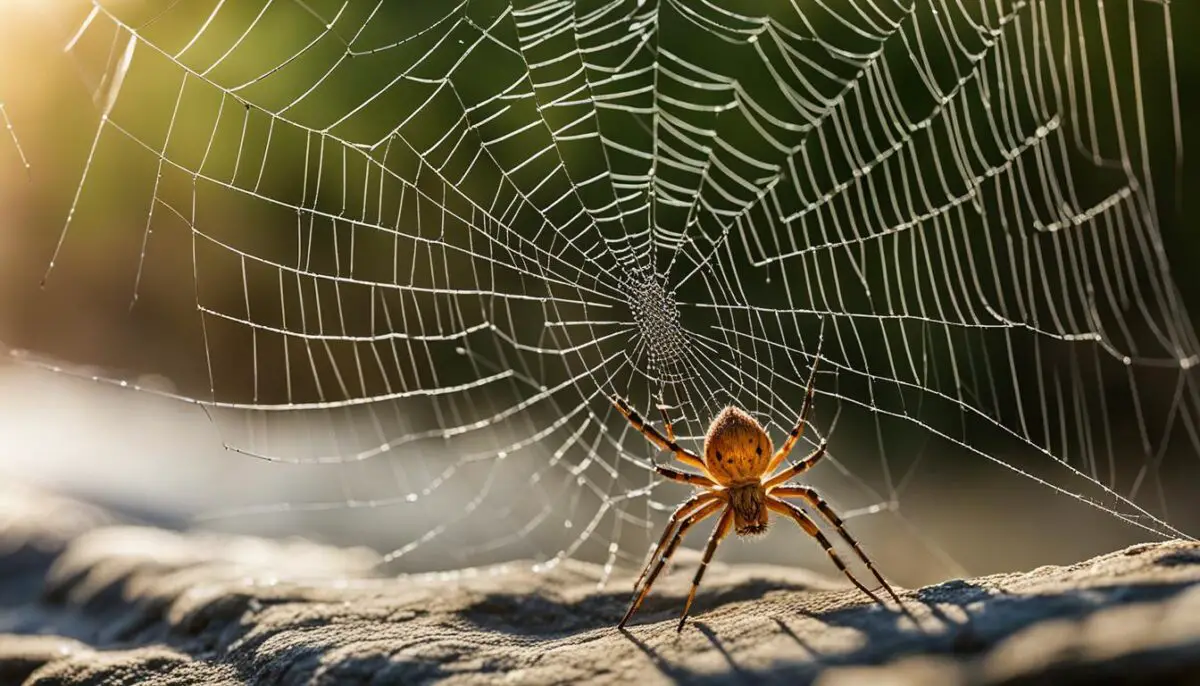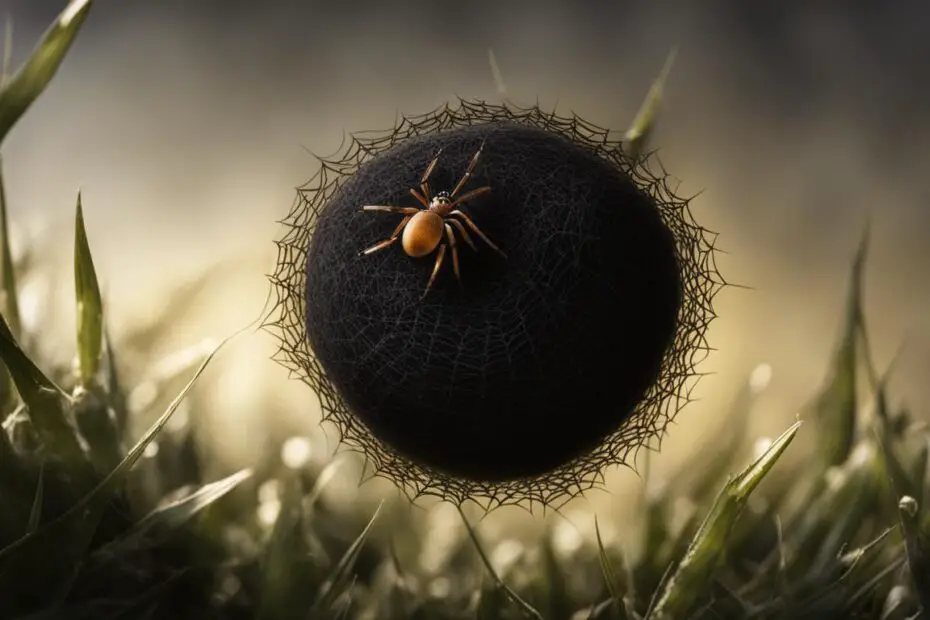Have you ever wondered how many spiders can hatch from a single spider egg? Well, you’re about to find out! In this article, we’ll explore the fascinating world of spider eggs and uncover the mysteries behind their quantity. From the construction of egg sacs to the survival of spiderlings, we’ll dive into all the intriguing details. So, let’s get started and unveil the secrets hidden within those tiny spider eggs!
Key Takeaways:
- Female spiders can produce egg sacs with varying numbers of eggs, ranging from several to a thousand.
- The number of spiderlings hatching from spider eggs depends on the species and the size of the egg sac.
- Spider egg sacs are constructed and protected to ensure the survival of spiderlings.
- Some spider species provide maternal care, guarding or carrying the egg sacs.
- Spiderlings undergo multiple molts as they grow and develop.
How Much Spiders Are in a Spider Egg
Spider Egg Sac Construction and Protection
Spiders go to great lengths to construct and protect their precious egg sacs. These sacs are made of multiple layers of silk, creating a sturdy and protective structure for the developing spider eggs. The female spider carefully deposits the eggs on a silk pad and wraps them to form a spherical or disk-shaped sac. Some species even attach their sacs to stalks or stones, while others cover them with smooth silk. how much spiders are in a spider egg
But it doesn’t end there. Some female spiders carry or guard their egg sacs, ensuring their safety from potential predators. These dedicated mothers may even regulate the temperature of the sacs, creating an optimal environment for the developing spiderlings inside. The construction and protection of these egg sacs vary among species, with different sizes and shapes influencing the number of spiderlings that will hatch. spider egg quantity
To give you an idea of the variability, let’s take a look at a table showcasing some spider species and the number of spiderlings typically found in their egg sacs:
| Spider Species | Number of Spiderlings in Egg Sac |
|---|---|
| Black Widow | 100-400 |
| Wolf Spider | Up to 200 |
| Orb Weaver | 100-300 |
This table provides a glimpse into the diversity of spider egg sac sizes and the corresponding spiderling populations. It’s fascinating to see how different species have evolved unique strategies to ensure the survival of their offspring.
Maternal Care and Spiderling Behavior
After hatching from spider eggs, spiderlings exhibit a range of behaviors depending on the species. While some spiderlings are independent from birth, others receive maternal care from the mother. This maternal care can involve guarding or carrying the egg sacs to protect them from predators and environmental conditions. spider egg spider count
For example, wolf spiders carry their spherical egg sacs attached to their spinnerets until the spiderlings are ready to emerge. This nurturing behavior ensures the survival of the spiderlings and increases their chances of reaching adulthood. The number of spiderlings in a single egg sac can vary from 20 to 100, depending on the species.
In addition to maternal care, spiderlings also demonstrate various behaviors once they emerge from the egg sacs. They undergo their first molt and start dispersing to avoid competition for food and prevent cannibalism. Some spiderlings walk short distances, while others use ballooning, a unique method of dispersal. Ballooning involves releasing fine silk lines that catch the breeze, carrying the spiderlings to new locations. spiderling population in spider eggs
Spiderling behavior and maternal care are fascinating aspects of the spider life cycle. Understanding these behaviors can provide insights into the number of spiders hatching from egg sacs and the survival rates of spiderlings. Additionally, it highlights the diverse strategies spiders employ to ensure the continuation of their species. spider eggs and spider birth rate
Spiderling Development and Molting
Spiderlings undergo a remarkable process called molting as they develop and grow in size. Molting is the shedding of their exoskeleton, allowing the spiderlings to replace it with a new, larger one. This process enables them to accommodate their increasing size during their growth stages. The number of molts that spiderlings undergo varies among different spider species. Generally, males mature earlier and undergo fewer molts than females.
Molting plays a crucial role in the development and survival of spiderlings. It allows them to adapt to their changing environments and acquire the necessary skills and characteristics for their adult lives. However, not all spiderlings are successful in molting. Some may fail to molt properly or experience delayed molts, which can negatively impact their growth and survival rates.
The duration of the spiderling development process varies depending on the species. While some spiders reach sexual maturity within a few months, others may take several years to complete their development. This variation is influenced by factors such as environmental conditions, availability of resources, and the specific needs of each spider species.
To visualize the molting process and its impact on spiderling development, refer to the table below:
| Molt Number | Spiderling Size | Maturity Timeframe |
|---|---|---|
| 1 | Small | Varies by species |
| 2 | Medium | |
| 3 | Medium to Large | Varies by species |
| 4 | Large |
As shown in the table, spiderlings typically experience multiple molts as they progress from small to medium-sized individuals and eventually reach their mature size. The time taken to complete each molt and the overall duration of the development process can vary significantly depending on the spider species.
Spider Egg Protection and Predators
When it comes to the survival of spider eggs, protection is crucial. Female spiders go to great lengths to ensure their eggs are shielded from physical damage, excessive drying, and predation. The silk sac that encases the eggs serves as a barrier against potential threats such as ants, birds, and parasitic insects. It provides a safe haven where the spiderlings can develop and eventually hatch.
However, despite the spider’s best efforts, some predators have evolved strategies to infiltrate or parasitize their eggs. Certain species of parasitic wasps, flies, and mantispid lacewings are known to lay their eggs among or within the spider egg sacs, taking advantage of the abundant food source. The battle between predator and prey continues as spiders employ various protective mechanisms to ensure the survival of their offspring.

The Role of Multiple Egg Sacs
To increase the chances of survival, female spiders often lay multiple egg sacs. By distributing their eggs across different sacs, they minimize the risk of losing all their offspring to a single predator attack. This strategy allows for a higher overall spiderling count, increasing the likelihood that at least some will successfully hatch and grow into adult spiders.
Moreover, female spiders may employ additional techniques to protect their eggs. Some species attach their sacs to stalks or stones, reducing the chances of ground-based predators reaching them. Others cover the sacs with smooth silk, making it difficult for smaller predators to grip and access the eggs. The diversity of these protective behaviors showcases the resourcefulness and adaptability of spiders in the face of potential threats.
| Spider Species | Number of Egg Sacs | Average Spiderling Count per Sac |
|---|---|---|
| Species A | 2 | 30-40 |
| Species B | 3 | 20-25 |
| Species C | 4 | 15-20 |
Table: Spider species and their typical number of egg sacs and average spiderling count per sac. These variations highlight the diverse reproductive strategies employed by different spider species.
Dispersal and Survival of Spiderlings
Once spiderlings hatch from the egg sacs, they undergo their first molt and gradually disperse to avoid competition for food and prevent cannibalism. Dispersal methods vary among species, with some spiderlings walking short distances, while others bridge or balloon to travel longer distances. Ballooning involves releasing fine silk lines that catch the breeze, allowing the spiderlings to be carried away. Only a few spiderlings will survive to adulthood due to predation, limited resources, and other environmental factors.
Table: Spiderling Dispersal Methods
| Species | Dispersal Method |
|---|---|
| Species A | Walking short distances |
| Species B | Bridging |
| Species C | Ballooning |
Spiderlings that disperse through ballooning release silk threads into the air and rely on wind currents to carry them to new locations. This behavior allows them to colonize new areas, find suitable habitats, and reduce the risk of inbreeding. Ballooning is particularly effective for long-distance dispersal and has been observed in a wide range of spider species.
Quote: “Ballooning is an extraordinary adaptation that enables spiderlings to explore new territories and expand their populations. It’s a remarkable sight to see thousands of tiny spiders suspended in the air, hitchhiking on strands of silk.” – Arachnid researcher
Despite their efforts to disperse and find new habitats, the survival rate of spiderlings is generally low. They face numerous challenges, including predation from other insects, birds, and small mammals. Limited availability of suitable food sources and resources also contribute to the high mortality rate. In addition, environmental factors such as temperature and humidity can influence the survival and development of spiderlings.
Spider Reproduction and Life Cycle
Spider reproduction involves intricate processes that result in the birth of numerous spiderlings. Female spiders have the remarkable ability to lay up to 3,000 eggs in one or more silk sacs. These sacs serve as protective cocoons where the spiderlings develop. Once fully developed, the spiderlings emerge from the sacs as miniature versions of adult spiders. The number of spiders hatching from each egg sac can vary depending on the species.
Throughout their life cycle, spiders go through three stages: egg, spiderling, and adult. The eggs incubate within the sacs until the spiderlings are ready to hatch. The spiderlings then undergo their first molt, shedding their exoskeleton to accommodate their growth. This process is repeated multiple times as the spiderlings continue to mature. Male spiders typically mature earlier and undergo fewer molts compared to females.
The average lifespan of a spider varies depending on the species, but it generally ranges from one to two years. Female spiders are often larger and stronger than males, and they play a crucial role in ensuring the survival of their offspring. Despite the large number of spiderlings that hatch, only a few will survive to reach adulthood due to predation, limited resources, and other environmental factors.
| Spider Reproduction | Life Cycle | Spider Lifespan |
|---|---|---|
| Females can lay up to 3,000 eggs. | Egg, Spiderling, Adult | One to two years |
| Spiderlings hatch from silk sacs. | Eggs incubate and develop within sacs. | Female spiders are often larger and stronger. |
| Number of spiderlings varies by species. | Spiderlings undergo molting as they grow. | Predation, limited resources, and environmental factors affect survival. |
Spider Habitat and Adaptability
Spiders are incredibly adaptable creatures and can be found in a wide range of habitats around the world. They have managed to colonize nearly every land habitat, excluding only the extreme environments of Antarctica. This remarkable adaptability is due in part to their ability to spin silk, which allows them to construct webs, nests, and shelters in various locations.
Common indoor spider habitats include basements, crawl spaces, closets, and areas under sinks where they can find protection and ample prey. Spiders are also known to thrive in outdoor environments such as gardens, forests, grasslands, and deserts. Whether it’s a cozy corner of your home or a leafy nook in the wild, spiders will make themselves at home wherever they can find shelter and a reliable food source.

Spiders have adapted to a wide range of climates, from hot and humid regions to cool and dry environments. They have evolved different strategies to survive in these diverse conditions. Some spiders are equipped with specialized structures that help them regulate their body temperature, allowing them to thrive in both extreme heat and cold. Others have developed water-repellent hairs or behaviors to prevent excessive drying in arid climates.
Adaptations and Survival Strategies
Spiders have evolved numerous adaptations to ensure their survival in different habitats. For example, web-building spiders have developed intricate silk structures to capture prey efficiently. Their webs vary in size, shape, and complexity depending on the spider species and its preferred habitat. Some spiders build horizontal orb webs, while others construct vertical orb webs or funnel-like structures.
Quote: “Spiders are master craftsmen when it comes to web construction, and their ability to adapt their web-building techniques to different environments is astonishing.” – Arachnid Expert
Spiders are also skilled hunters and have developed various techniques to catch prey. Some actively stalk their victims, relying on their agility and venomous bites to incapacitate their prey. Others employ stealth and camouflage to ambush unsuspecting insects. These adaptations have allowed spiders to occupy a wide range of ecological niches and play a vital role in maintaining the balance of ecosystems.
| Spider Adaptation | Habitat |
|---|---|
| Web-building spiders | Garden, forest, meadow |
| Hunting spiders | Desert, grassland, tropical rainforest |
| Burrowing spiders | Sandy or soft soil |
| Cryptic spiders | Bark, leaves, rocky crevices |
Spiderling Population in Spider Eggs
The number of spiders hatching from spider eggs can vary greatly depending on the species and environmental conditions. Some spider species produce large clutches of eggs, while others have smaller broods. The spiderling population in each egg sac can range from a few dozen to several hundred, ensuring the survival of enough spiderlings despite the risks of predation and environmental challenges.
- Species A: 50-100 spiderlings per egg sac
- Species B: 200-300 spiderlings per egg sac
- Species C: 500-700 spiderlings per egg sac
This variation in spiderling population reflects the diverse reproductive strategies of spiders and their ability to adapt to different ecological conditions. By producing multiple egg sacs or adjusting the number of eggs in each sac, female spiders can optimize the chances of their offspring’s survival and ensure the continuation of their lineage.
Spider Benefits and Pest Control
Spiders play a crucial role in pest control by preying on other insects, making them valuable allies in both indoor and outdoor environments. Their ability to catch and consume a wide variety of pests helps to naturally regulate pest populations, reducing the need for chemical pesticides. While many spiders build intricate webs to ensnare their prey, others actively hunt for food, making them efficient and effective predators. This natural pest control service provided by spiders is particularly beneficial in gardens, where they can help protect plants from harmful insects.
One of the advantages of using spiders for pest control is their adaptability to different environments. They can be found in a wide range of habitats, from gardens and houses to forests and fields. Spiders are highly adaptable creatures, capable of surviving in both hot and cool climates, wet or dry environments. Their ability to thrive in various settings makes them accessible and effective pest controllers in diverse locations.
“The role of spiders in eliminating pests from gardens is invaluable. Their hunting skills and ability to catch a wide range of insects make them natural and environmentally friendly pest control agents.” – Dr. Samantha Green, Arachnologist
Although spiders provide essential pest control services, it’s important to strike a balance between their presence and the level of comfort in human living spaces. While most spiders are harmless and pose no threat to humans, understanding the difference between venomous and non-venomous species can help address any concerns. Implementing non-lethal methods to remove or relocate unwanted spiders from living areas can maintain a harmonious coexistence.
| Spider Benefits and Pest Control | Summary |
|---|---|
| Pest Control | Spiders prey on other insects, helping to naturally regulate pest populations in indoor and outdoor environments. |
| Adaptability | Spiders can be found in various habitats, making them accessible and effective pest controllers in diverse locations. |
| Expert Quote | “The role of spiders in eliminating pests from gardens is invaluable. Their hunting skills and ability to catch a wide range of insects make them natural and environmentally friendly pest control agents.” – Dr. Samantha Green, Arachnologist |
| Coexistence | Understanding the difference between venomous and non-venomous spiders can help address concerns, promoting a harmonious coexistence between spiders and humans in living spaces. |
Overall, spiders provide an essential service in pest control by preying on insects that may pose a threat to plants, human health, or general well-being. Their adaptability, hunting skills, and ability to catch a wide range of pests make them effective and environmentally friendly pest controllers. As long as a balance is maintained, spiders can play a valuable role in managing pest populations while coexisting with humans in various habitats.

To foster a better understanding of spiders and their important ecological role, it can be helpful to learn about their life cycle, behavior, and habitats. By recognizing the value spiders bring to our environment, we can appreciate their presence and coexist with them more harmoniously.
Conclusion
Spiders, with their diverse reproductive strategies, exhibit fascinating variations in the quantity of spider eggs and the number of spiderlings hatching from them. Female spiders play a crucial role in protecting and caring for their eggs, employing various strategies to ensure the survival of their offspring. However, the survival rate of spiderlings is influenced by factors like predation and environmental conditions.
Understanding the life cycle, behavior, and habitats of spiders provides valuable insights into their remarkable adaptability. From constructing elaborate silk egg sacs to dispersing and molting, spiders display intricate processes that contribute to their survival. The number of spiderlings in each egg sac can vary significantly, ranging from a few to hundreds, depending on the species and the size of the sac.
By preying on other insects, spiders contribute to natural pest control, making them beneficial to have in both indoor and outdoor environments. It is essential to differentiate between venomous and non-venomous spiders to address any concerns and promote coexistence. Increasing our knowledge of these unique creatures enhances our appreciation for their vital role in the ecosystem.
FAQ
How many spiders are in a spider egg?
The number of spiders in a spider egg can vary greatly depending on the species. Female spiders can produce one egg sac with several to a thousand eggs or multiple egg sacs with decreasing numbers of eggs.
How many spiderlings hatch from spider eggs?
The number of spiderlings hatching from spider eggs varies depending on the species and size of the egg sac. It can range from 20 to 100 spiderlings in a single egg sac.
Do all spiders protect their egg sacs?
While most spiders construct elaborate and protective egg sacs, not all spiders exhibit the same level of maternal care. Some spiders carry or guard their egg sacs, while others simply deposit them and do not provide any further protection.
What is the purpose of the silk sac that surrounds spider eggs?
The silk sac provides a barrier against predators like ants, birds, and parasitic insects. It helps protect the eggs from physical damage and excessive drying.
How do spiderlings disperse after hatching?
Spiderlings disperse to avoid competition for food and prevent cannibalism. They may walk short distances, bridge using silk lines, or balloon by releasing fine silk strands that catch the breeze and carry them away.
How long does it take for spiders to reach sexual maturity?
The development time varies depending on the species. Some spiders can take up to several years to reach sexual maturity.
Do all spiders prey on other insects?
Yes, spiders are primarily insectivores and feed on other insects. They play a beneficial role in controlling pest populations, particularly in gardens.
Where can spiders be found?
Spiders can be found in a wide variety of habitats, excluding Antarctica. They can adapt to different environments, including gardens, houses, and natural habitats.
Are spiders dangerous to humans?
While some spiders are venomous, the majority of spider species are harmless to humans. It’s important to understand the difference between venomous and non-venomous spiders to address any concerns.
How long do spiders live?
The average lifespan of a spider varies depending on the species but is generally up to one or two years.
